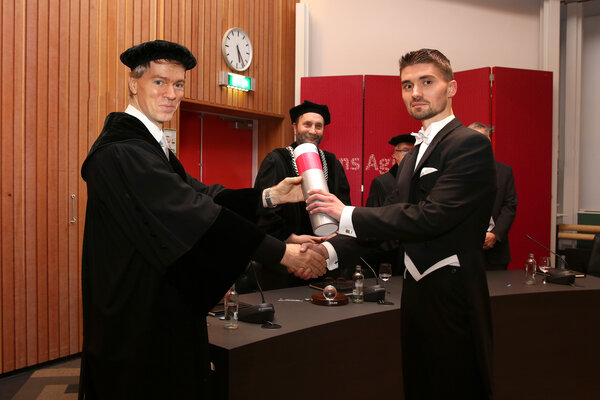Making organic electronics in the same way coffee stains dry

Many organic electronics, like flexible solar cells, are made by applying a thin layer of solution in which a polymer is dissolved. The evaporation of the solution determines the thickness of the polymer layer that is left behind, and that thickness is decisive for the ultimate performance of the solar cell. Bèr Wedershoven developed a series of methods to precisely control this process. He can make minuscule patterns much like the darker edges that form at the rim of a drying coffee stain. For this research Wedershoven received his doctorate with distinction on Wednesday 6 December.
One of the methods Wedershoven developed to determine the thickness of the residual polymer layer is to ‘blow’. This causes more of the solution to evaporate at the spot where the blowing occurs, allowing extra polymer to flow to that spot such that the final layer is thicker there. For this purpose he developed a nozzle that blows the dry air and, at the same time, removes the humidified air in the direct vicinity. The patterns measured 1 millimeter, and it is expected that 10 times smaller is feasible.
Wedershoven also managed to enable the creation of spontaneous patterns on a substrate that is lifted out of a tray of solution. When the substrate is lifted out of the solution slowly, the liquid sticks a little to the substrate and evaporates at the same time, thereby creating a rippling pattern but only when the substrate is lifted out of the liquid at a specific speed. The ripples are some 100 micrometers wide.
The local wetting of a substrate is a frequently applied step in micro-electronics production. This involves submerging the substrate, which, in principle, only retains the solution in specific spots. However, if the substrate is lifted out of the solution too quickly, then the solution also remains in spots where this is unwanted. On the other hand, speed is of the essence in the industry. So Wedershoven developed a method to accelerate the process: by shining an infrared laser on the edge of the dispersing solution on the substrate. This reduces the viscosity, or increases the fluidity, enabling the solution to move more easily and leaving behind no solution at higher speeds.
This method also revealed that it was possible to adjust the thickness of a layer of solution. The shining of infrared laser lowers the surface tension whereby the solution is pushed aside and the layer becomes thinner. Wedershoven also developed a variant that does exactly the opposite. Shining a UV beam causes a photochemical reaction to take place in the solution, which increases the surface tension. In turn, the solution flows towards the illuminated spot, resulting in a thicker layer.
A very special aspect of this research is that each process described has been studied both experimentally and using extensive numerical models. Bèr Wedershoven did his research in the group of prof.dr. Anton Darhuber. The work is part of the NWO program ‘Active control of solution processing of organic electronic devices’.